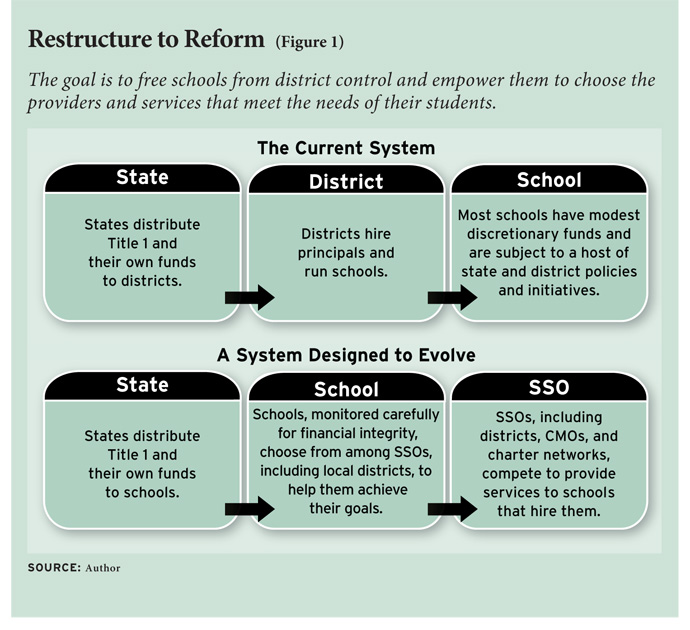It’s no surprise that, 28 years after the publication of A Nation at Risk, school-reform efforts have generated so little effect. Our schools have proven, over the past century, quite adept at resisting change.
Recent attempts to inject accountability and innovation have brought us to an important opportunity. No Child Left Behind helped add transparency, and Race to the Top (RttT) motivated states to rethink teacher evaluation, charter limits, and more. The Investing in Innovation fund (i3) has seeded some promising innovations and helped attract more private investment to public education.
But none of these initiatives hits at the reasons that education has proven itself so innovation-resistant: governance and compensation. Further, there is good reason to believe a third impediment—the absence of useful data—will persist even through the Common Core State Standards initiatives.
Finland serves as a model for many reformers. There is a single curriculum; teachers are well educated and well respected. Their system reflects Finnish ideals and builds on Finnish strengths, and their students score at the top of international tests like PISA (Program for International Student Assessment) and TIMSS (Trends in International Mathematics and Science Study).
But a top-down system will continue to be the wrong approach in this country, whether on a national or state level. It doesn’t reflect American values or culture, nor does it address the size, diversity, or income disparity of the United States. (Finland has half as many students as New York City, and only 13 percent live in poverty.) In a country of 300 million people, a top-down approach makes substantive change virtually impossible. To fix our schools, states have to stop trying to fix them; the quickest way to raise performance is command and control, but over the long run martial law does not even work well for generals.
States can create a more agile, more American, system of governance that eliminates impediments to improvement, empowers schools to innovate, and uses data to help families find the right schools for their children. The federal government should encourage them to do so.
None of the proposals below address the role of profitmaking companies in K‒12 education (though my bias might be clear, as I have run education companies for 30 years). It is important not to conflate marketplace with for-profit. It is also important to recognize that it takes time for deregulation and a newly formed marketplace to work. The breakup of AT&T and the telecommunications bill of 1986 did little to help consumers in the very short term, but they cleared the path for lower costs and technologies including the Internet and the cellphone. Occasionally efforts to create a marketplace don’t work at all, as happened with banking deregulation. As education is a public good and requires public funding, proposed structures should be measured by the incentives they will create for schools, districts, and teachers to produce great student outcomes at reasonable expense.
Empower Schools
Although our ultimate goal is a system of schooling that naturally evolves and improves, it’s important to keep in mind that the capacity for experimenting and innovating resides in individual schools, not in central offices. Under the current system of governance and funding, schools have too few resources and too little discretion for experimentation. Without the dollars to implement novel ideas and to discover what works and what doesn’t, most schools look for, at most, incremental improvement.
Right now, every state distributes state and federal funds to districts; in turn, the districts distribute funds to schools. Imagine that states instead channel funds directly to schools and require that the schools contract with a school support organization (SSO) for an array of services similar to what its district’s central office now provides (see Figure 1). There are many ways to implement such a plan, but the recent transition of New York City schools to its empowerment model might serve as a useful example, even though the city may be losing its resolve to change.
Ideally, existing school districts would be spun off as independent nonprofits and freed to compete with other districts, as well as with the new SSOs in the nonprofit and for-profit sectors, for schools and dollars. University of Washington research professor Paul Hill and others have proposed variants of this concept.
Since most schools (especially those in small and wealthy districts) would probably keep their existing districts as their service providers at first, the initial shift would be subtle. But before long the roles and behavior of schools and districts would begin to change. Freed to choose a district or other SSO based on service, cost, and philosophy, schools would demand more for less, and SSOs would step up to pull schools away from their local districts and compete by differentiating themselves from their competitors. Perhaps they would charge less for similar services; perhaps they would deconstruct the services, providing only busing, technology, or financial/purchasing support. Eventually, districts and SSOs would also vie for schools based on their track records of learning outcomes.
Under this proposal, districts would become providers of services rather than owners of geographic zones. With their schools acting as clients rather than dependents, districts would be forced to compete for them, thereby becoming more innovative and cost-effective.
Concrete results would take a while to materialize, but they would come. The current system of big-district purchasing, for example, favors large textbook publishers, which play it safe. School-level purchasing—with proper financial controls—would allow smaller, more responsive companies to compete for business.
Charter schools are the one reform initiative of the past three decades that has addressed the issue of K–12 governance and gained some traction (some 5 percent of public schools are now charters). This proposal builds on some of the lessons learned from the charter school movement and would allow effective charter networks like Green Dot, KIPP, and North Star to operate as school support organizations on a level playing field with districts, with equal funding and authority. A great deal of innovation today is coming from charter networks; this change would encourage districts to match them.
Most states would need to implement significant initiatives to prepare school principals for their new role, and to recruit new principals with the right skills; education schools and programs like New Leaders for New Schools could participate in this effort. Further, states would need to balance power between districts and schools; for example, districts should have the power to reject association with a poorly performing school. Both schools and districts should be pushed to improve themselves and their products and services.
Accountability would become simple (and imperative) under this model. The newly empowered schools should live or die by their performance; similarly, SSOs would lose their customers if they proved unable to support high achievement (which is how the stock of K12, Inc., lost 40 percent of its value following a single critical article in the New York Times). Accountability goes hand in hand with empowerment; promoting one without the other will not succeed.
Empowering schools would also mean encouraging parental choice. After the district’s monopoly is broken up, it would be critical that states create intelligent, consumer-friendly systems to support parents in choosing their children’s schools. Any number of successful models exist, all of which would provide transparency and could be used to balance families’ desire for schools within reasonable distance with their desire for the right outcome.
This is not an easy change; further, many districts are already well run and don’t need change at all. But this proposal would remake the relationships between schools, districts, and states into a far more efficient and effective model, one that would increase agility and remove regulations that limit the autonomy of school leaders. (As Arizona congressman Jeff Flake once asked, “Who out there can sing their district fight song?”)
Offer Teachers a New Deal
Once we’ve empowered schools, we’re ready to address teacher compensation. Many people believe that teachers unions are a major cause of whatever they think is wrong with our schools. It’s not that simple; plenty of research suggests that districts without unions do not perform better than those that have unions, and are only slightly less expensive.
To be sure, pensions and tenure are huge impediments to organic change. But two parties signed the contracts putting them in place: the union, whose job is to get its members more pay for less work, and the district. It was the side representing kids—the districts and state legislatures—that failed. Demonizing unions and teachers is unfair and counterproductive.
The problem isn’t the total compensation; if anything, teachers are underpaid. It’s the structure of that compensation, a series of long-term obligations that severely limit agility while creating off–balance sheet debt that would make Wall Street blush. (According to district budget figures, New York City, for example, spends as much on teachers who no longer teach as on those who still do.)
Ending tenure without ending the current pension system would create some impossible pressures; teachers nearing certain vesting thresholds, for instance, would have a target on their backs. To create an agile system, states must end both tenure and pensions. We can take a big step down this road without reneging on commitments made to a generation of teachers who have accepted lower base salaries for long-term benefits. The starting point, in fact, is something many teachers would embrace.
States should give each teacher the right to choose an alternative contract that contains terms and benefits consistent with those in the private sector (e.g., an at-will contract with standard health-care benefits, 401k, etc.), and sits outside of the existing teacher pension system. Choosing this alternative contract would convert any existing pension to a lump-sum 401k contribution. In return, the new contract would have a far higher base salary; in fairness, states should require districts to hire an auditor to determine the savings that can be expected from each alternative contract teacher, and give that savings to the teacher as increased pay.
Under this plan, no current teachers would be forced to change their contracts. If a state chooses to implement this policy change on a school-by-school basis, teachers who choose the current traditional contract might be offered a transfer or be grandfathered, that is, allowed to continue under their current contract. But the alternative contract could be attractive: depending on the state or district, the expected pension-related savings over a standard contract could be as much as $25,000 per year per teacher. In New York City, for example, a teacher might choose her current contract and a $65,000 salary, or the alternative employment terms with a $90,000 salary but with no tenure guarantees. This change would not reduce costs overall, but it would begin to curb the practice of paying operating expenses with long-term, off–balance sheet debt.
Conversion specifics will vary by state; obviously, those with huge unfunded liabilities will have a tougher time finding an elegant solution to converting past pension obligations for teachers nearing vesting milestones. Some percentage of teachers will refuse to switch; every teacher who does switch, though, will reduce the scope of the long-term problem. Many teachers will prefer to have their retirement funds fully in their control, along with a higher base salary, over a pension subject to fierce political pressure.
So which teachers might choose the alternative contract? My hunch is that newer teachers, who would appreciate the extra cash, and high-performing teachers, who would be unconcerned about the decreased job security, would be likely converts. If that’s true, it’s probable that schools with the highest-need students (who traditionally have the least-experienced faculty) would be most likely to convert over to the new contract, and might thereby be able to attract higher-performing teachers.
Schools operating under the alternative contract would be free to evaluate teachers based on student performance and evaluation, as well as classroom observation and other evidence. These teachers could be empowered to shape their schools, by taking part in choosing the curricula they use in their classrooms and the formative assessments they use to measure student progress, for example. Giving teachers a voice in decisions that affect their work is a logical complement of recognizing and compensating them as professionals rather than as assembly-line workers.
Does this proposal solve the compensation problem? Not entirely, though it would take us halfway there. If we also clean up our accountability systems, we could compare the performance of teachers under each contract and adjust the compensation system to include performance metrics as appropriate.
Align Assessment to Curricula
For all their deficiencies, assessments of student learning are an indispensable component of an evolving school system. Without accurate assessments aligned with curricula and standards, education innovators would be flying blind.
The multistate Common Core State Standards project is an improvement over the patchwork of past state standards. But the standards are not the source of flaws in state accountability systems; the culprits are the state tests.
Tests used by international organizations, like TIMSS and PISA, and also our own NAEP (National Assessment of Educational Progress), can measure performance because they’re both broad and deep; they use a reasonable number of items (many of which are constructed responses) against a large number of standards. But that design makes those tests too long to give to one student. Instead, they’re matrixed; 10 students might each take one-tenth of the test. A few thousand well-selected subjects might give us an accurate picture of 4th graders in a state, but these types of tests cannot be used to measure the performance of a student or school.
A state or national test, on the other hand, can only last an hour or two in each subject. Because such tests must contain several items per standard to be accurate, it will measure only a fraction of the standards. And since a test must be reliable from year to year, it will measure that same subset every year. This limitation encourages schools to narrow their curricula to only those standards likely to be measured and gives rise to illusory performance gains. At present, various groups of states are trying to work out this problem. In the end, they’ll trust that the testing companies will solve this problem, and once again, they’ll be disappointed. There’s a better path.
Imagine if states stopped commissioning their own tests and instead created a small set of requirements for each curriculum provider:
• Adopt or create a secure summative test for each grade level. This test should align closely to the curriculum, and every school using that curriculum would use that test to measure student performance.
• Work with client schools to administer NAEP (or some other matrix-based test aligned to the standards) to 2,000 students each year in key grade levels; use their performance to set the curve for the summative test (think of this as “Curriculum NAEP,” the equivalent of the current state NAEP testing).
• Set the curve for tests on a standard score range that facilitates value-added analysis.
This new way of thinking about summative testing would retain the advantages of the Common Core project and the best state tests while eliminating most of the disadvantages. States would retain the authority to determine the curricula they might subsidize or even allow; they might adopt only one for some subjects and grades (say, for K–6 math); in this case, the world would look a lot like it does now. States would be better off, however, allowing schools to adopt curricula, along with the corresponding summative tests, that best fit their students’ needs. Again, it makes sense to empower schools at the same time that we hold them accountable for student performance. Either way, states could continue to compare schools, since each curriculum would be scored on the same curve and the scores equated through Curriculum NAEP.
This proposal would eliminate most gaming around test scores. There would be no incentive for a provider to dumb down its test, since Curriculum NAEP scores (and therefore the curve) would leave scaled scores unchanged. Moreover, the proposal would create a true alignment between curricula and tests, by removing the state as intermediary. Rather than teach to the state test, schools would teach a curriculum, and then test students accordingly.
Best of all, this regimen would encourage differentiation and competition among curriculum providers. In the end, the curriculum generating the best results for a particular cohort (say, middle-school Latina students) would likely be adopted by schools with large groups of those students.
That competition would extend to the tests themselves. A test should be judged not only by its accuracy, precision, and reliability, but also by its ability to promote learning. Many educators believe that authentic assessment (asking students to perform complex tasks rather than answer multiple-choice questions) encourages better teaching and learning; if this proves true, then curriculum providers using authentic assessments would dominate the market, despite their higher costs.
Finally, this approach would save money. Curriculum providers will find much more agile ways to connect to assessment providers than any state consortium has found so far.
Let the Data Flow
If our schools are to continually improve, we need to gather data and make it available not just to schools, school districts, and parents, but also to independent researchers, who can comb the databases for correlations and any underlying causal connections. Our goal should be to create a veritable education genome project open to all appropriate parties, with proper security measures to address privacy concerns.
We currently gather data through a 1970s-era approach that is slow and expensive. As data move from classroom to school to district to state to the federal government, the details that would allow us to draw meaningful conclusions about things like the effectiveness of a textbook, a supplemental services provider, or an afterschool program are lost. Meanwhile, Google and others manage much more data with far less cost and difficulty. We need to adapt their processes to education data.
The testing companies already collect data from individual schools, as they send and collect test booklets either directly or through the district. These vendors are technically savvy and have the incentive to maintain participation in a lucrative assessment market. States should require their testing vendors to collect data from each school in a standard format, including at least the curricular materials used in each classroom, the calendar and schedule in use at that grade level, the background of the teachers, and any academic interventions used for particular students. The companies should be required to then forward these instructional data, along with test scores, subscores on specific components of the test, and student demographic information, to the state in a standardized format. The state, in turn, should publish a database with accounts allowing schools, districts, education consumers, and (in a privacy-ensured format) researchers to access at will.
There are obvious privacy concerns about publishing personal data in a state database. However, these data are far less sensitive than other data that are commonly secured and made widely available. (Just what would someone do with your son’s 5th-grade math grades?)
Thousands of researchers would surely exploit the resulting database. Curriculum providers would look for evidence of their (or their competitors’) effectiveness. Policymakers would examine the results of various interventions, including afterschool programs, changes in class and day length, or class-size reductions. Teacher preparation and in-service training programs would know whether and where they were having an impact. Parents would be able to make informed choices about where to send their children to school.
Most states would save money by making use of this more efficient way to collect data. At the same time, it would spawn a wave of innovation, as various players start using the data.
Innovation and the New ESEA
All four of these proposals would move us away from a command-and-control education system, and toward an agile education marketplace that encourages innovation and excellence. But even if these proposals sound reasonable to you, you’re probably still wondering how and when they might ever come to pass.
The answer is through the next iteration of the Elementary and Secondary Education Act (ESEA); by attaching the mind-set of RttT and i3 to the billions of dollars of annual education aid to states, we can use incentives to encourage the right behaviors quickly and inexpensively. Title I channels $14 billion per year to states, which pass it along to districts along with their own funding. Imagine if the new law leads states to channel that money, along with their own funds, directly to schools, and discourages them from holding to the status quo. With a small tweak (for example, an increase or decrease in funding of 10 percent), the feds would give states a $3 billion push in the right direction.
The language enabling schools to choose a district or SSO should be simple. Each state should find its own path to empowering schools. Perhaps some states would empower high-performing schools first, while others might put failing schools into governors’ districts like the one currently proposed in New Jersey. Perhaps states with higher population density would create statewide choice systems, while others would favor parents who sought short travel times. There are many mechanisms imaginable for allowing a school community to vote on its district or SSO affiliation and for states to license and monitor school support organizations.
Similarly, Title II provides roughly $3 billion per year for professional development. The federal government could limit those funds to states that give teachers the right to choose the alternative contract. Again, though, the new ESEA should allow states great latitude in structuring that right (for instance, they could give that choice to individual teachers, or allow a school-by-school vote); regardless, each state will have to figure out what to do with its pension obligations to teachers who switch to the new contract.
The process by which Common Core states are creating math and English tests is well under way; it may result in top-notch exams that lead to dramatic performance increases. The easiest place to implement an assessment marketplace, then, is in science, history, and language courses. ESEA should establish a group that registers curricula in those areas; if this marketplace proves effective and states struggle with the Common Core tests, this marketplace can easily expand to incorporate math and English.
The accountability provisions of ESEA should require testing companies to phase in collection of school-level instructional and background data. Initially, the testing companies could provide the data to client states for analysis; perhaps down the road, states or foundations will find it useful to run studies across multiple data sets.
None of these proposals is expensive; in fact, most will save money in the short and long term. And although some might be politically inexpedient, none would have the natural and well-funded opponents of other commonsense reforms. Further, this is not an exhaustive list. Every reader of this article could probably come up with additional reforms that would create a more responsive education system.
This plan places a great deal of faith in competition and innovation, though within the construct of a robust public school system. As I’ve noted, this faith could be misplaced: perhaps education truly is different, and there simply is one immutable right way to run schools. But there is something to be said for empowering our schools with transparency, choice, and agility. American ideals shouldn’t just be taught in the classroom; they should shape that classroom.
John Katzman is the executive chairman of 2tor, Inc.
This article appeared in the Spring 2012 issue of Education Next. Suggested citation format:
Katzman, J. (2012). Putting the Schools in Charge: An entrepreneur’s vision for a more responsive education system. Education Next, 12(2), 32-38.








